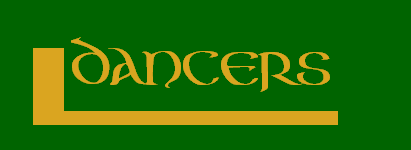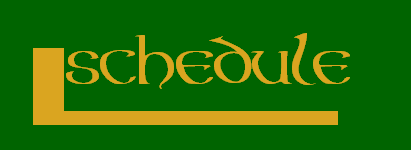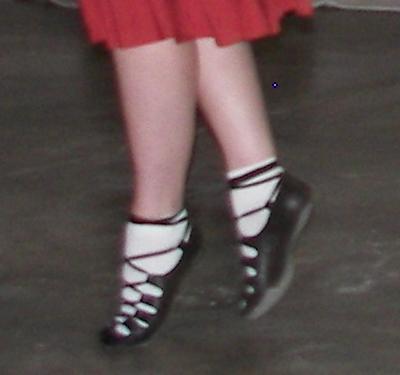CLOTHING FOR CLASS
GIRLS - Please arrive in cheerleader shorts. Cotton is preferred, because it is less restricting. These can be bought at most stores that sell uniforms for team sports. There are several brands available. The most common brand is Soffe, and they are a good choice because they are short with out being too short. They are made for cheerleaders so they will be less likely to rip when put through all the torture of Irish Dance! Please do not come in shorts that are long, even in cotton, they restrict the movement. If you are uncomfortable with the length of these shorts, feel free to wear biker shorts under or instead of them!
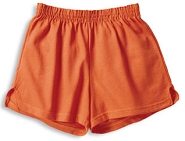 LADIES - Please wear comfortable shorts or a short skirt. If you are not comfortable with your legs, please wear black tights like the instructor often will. Socks may be worn over tights.
LADIES - Please wear comfortable shorts or a short skirt. If you are not comfortable with your legs, please wear black tights like the instructor often will. Socks may be worn over tights.
Ladies and Girls may wear T-shirts, but they need to fit. Loose or baggy shirts make it difficult to detect posture problems. Tank tops are permitted as long as they are decent (completely cover and are fitted around the arm pit)!
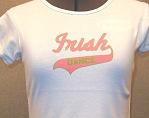 Long hair must be neatly pulled back out of face. If your hair is too short to secure with an elastic band, but long enough to get in your face, please wear a head band or clips!
Long hair must be neatly pulled back out of face. If your hair is too short to secure with an elastic band, but long enough to get in your face, please wear a head band or clips!
GENTS/BOYS - Boys need to arrive in shorts. They should be cotton and MUST be above the knee. There is a male version of the girl�s cheerleader shorts that are longer with out being too long (or too short), but they are much more difficult to find. Just make sure that they are not restricting and are above the knee. Basketball shorts that end above the knee are an acceptable alternative.
Boys may wear T-shirts, but like the girls, they need to fit. Baggy or loose clothes make it difficult to detect posture problems. Boys may also wear tank tops, but they also need to fit (not falling off and again, fitted in the armpits).
Males who have hair long enough to get in their eyes must secure it out of their face.
ALL STUDENTS � Dancers must wear socks with their dance shoes. For girls, poodle socks are acceptable but not required. All dancer�s socks should be fitted. Socks that are too big can cause serious blisters. SOCKS MUST BE CLEAN! If this were not a rule, with all the shoe changing we do, the room would really stink!
DURING WINTER - Dancers must still wear the above dress code, but MUST arrive at dance class with arms and legs covered. Sweat suits or dance pants - No Jeans! Dancers may begin to remove their sweats as they warm up.
This dress code is for the good of the dancers, and helps ensure the quality of their lessons and the safety of their joints and muscles. Please adhere to it!
SHOES FOR CLASS
An Irish dancer�s shoes are his or her most important piece of equipment. While a certain pair of shoes will not make the student a better dancer without practice, the wrong shoes, whether too tight, too loose, or just plain uncomfortable, can make a dancer miserable!
There are two types of shoes used in Irish dance. The first type is the soft (or light) �reel� shoe. For girls, these shoes are often called ghillies. They are black leather ballet-type slippers that are laced up the front and tied around the ankle and foot. Below is an illustration of a pair of ghillies. For Ceili class, an inexpensive alternative would be beginner ballet shoes.
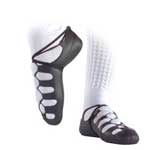 For boys, the soft shoes are similar to traditional leather jazz shoes. However, the shoes have a hard heel added to them so that the boys can create sound with the shoes in the course of their dancing. Below is an illustration of a pair of boy�s soft shoes.
For boys, the soft shoes are similar to traditional leather jazz shoes. However, the shoes have a hard heel added to them so that the boys can create sound with the shoes in the course of their dancing. Below is an illustration of a pair of boy�s soft shoes.
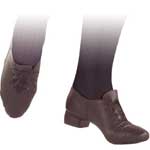 The second type of shoe is the hard (or heavy) �jig� shoe. Both boys and girls wear the same style of hard shoe. These shoes are leather oxford style shoes that create a distinctive sound with thick tips and heels. The tips and heels of today�s hard shoes are typically made of fiberglass or other types of composite materials that create a loud sound. An illustration of a pair of hard shoes is below.
The second type of shoe is the hard (or heavy) �jig� shoe. Both boys and girls wear the same style of hard shoe. These shoes are leather oxford style shoes that create a distinctive sound with thick tips and heels. The tips and heels of today�s hard shoes are typically made of fiberglass or other types of composite materials that create a loud sound. An illustration of a pair of hard shoes is below.
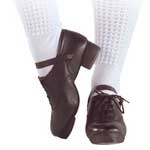 Shoes are a major investment for all dancers. A pair of new soft shoes will typically run from $40 to $90, depending on brand and style. Hard shoes are even more expensive, and will generally cost around $100 for beginner style hard shoes (available through AAIDT - see the links page) to $140 to $200 for championship level shoes, again depending on brand. Before you panic over the cost, however, be aware that there are other options for the budget conscious parent or student. You will often find parents and students who are selling used pairs of shoes (especially ones that have been grown out of) at a reduced price. Also, the school will soon have a small stock of shoes to loan to dancers who need them. These shoes are usually in the smaller sizes, and may be �well loved�, having gone through several dancers before being placed in the box. Also, you can often find used shoes on the internet, through Ebay or dedicated dance resale sites such as Dance Again.
Shoes are a major investment for all dancers. A pair of new soft shoes will typically run from $40 to $90, depending on brand and style. Hard shoes are even more expensive, and will generally cost around $100 for beginner style hard shoes (available through AAIDT - see the links page) to $140 to $200 for championship level shoes, again depending on brand. Before you panic over the cost, however, be aware that there are other options for the budget conscious parent or student. You will often find parents and students who are selling used pairs of shoes (especially ones that have been grown out of) at a reduced price. Also, the school will soon have a small stock of shoes to loan to dancers who need them. These shoes are usually in the smaller sizes, and may be �well loved�, having gone through several dancers before being placed in the box. Also, you can often find used shoes on the internet, through Ebay or dedicated dance resale sites such as Dance Again.
|


